Coobah, Willow Wattle
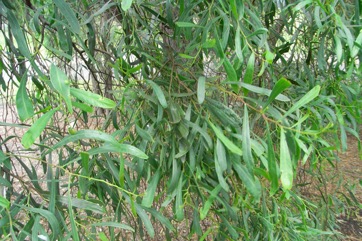
It grows in Mediterranean climate places. It occurs naturally in mainland Australia. It can grow on many soils but prefers heavy clays. It requires an open sunny position. It is drought and frost resistant. They are mostly found along streams. They are very hardy. It can grow in semi arid places but benefits from water during the dry season. It normally occurs south of 20°S latitude. It probably does best where summers are hot and rainfall is 35-55 mm. It can grow in arid places. It suits hardiness zones 8-9.
Also known as:
Broughton willow wattle, Dhulan, Doolan, Murray willow, Native Willow, Swamp wattle, Umung, Thulga winna
Synonyms
- Acacia varians Benth.
- Racosperma salignum (Labill.) Pedley
Edible Portion
- Seeds
Where does Coobah grow?
Found in: Africa, Asia, Australia, Britain, East Africa, Egypt, India, Israel, Libya, Mediterranean, North Africa, Tanzania, Tunisia, Zimbabwe
Notes: There are about 1,350 Acacia species. Over 1,000 occur in Australia. Also as Mimosaceae.
Growing Coobah, Willow Wattle
Cultivation: It is grown from seed. The seed need treatment to break the hard seed coat. Normally this is by putting the seeds in very hot water and letting the water cool down overnight then planting the seeds immediately. The plants spread by suckers. Because of the range of climates where it will grow, it is best to collect seeds from within the area where it is to be produced.
Edible Uses: The seed are eaten. They are ground into flour and made into bread.
Production: It grows quickly. The flowers occur June to October and the pods mature August to December.
Nutrition Info
per 100g edible portion| Edible Part | Energy (kcal) | Protein (g) | Iron (mg) | Vitamin A (ug) | Vitamin c (mg) | Zinc (mg) | % Water |
|---|---|---|---|---|---|---|---|
| Seed | - | - | - | - | - | - |
Coobah, Willow Wattle Photos

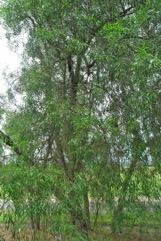
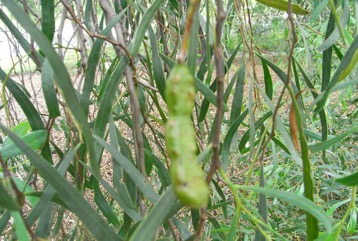
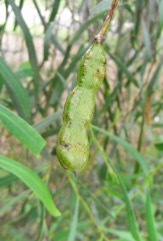
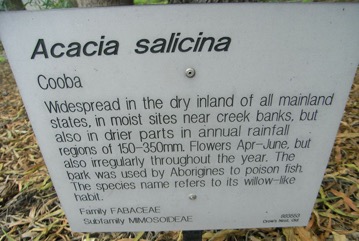
References
Anon., 2003, Native Plants for the Fitzroy basin. Society for Growing Australian Plants Inc. (Rockhampton Branch)
Bodkin, F., 1991, Encyclopedia Botanica. Cornstalk publishing, p 32
Bonney, N., 1997, Economic Native Trees and Shrubs for South Australia. Greening Australia (SA) inc. Campbelltown SA 5074 p 19
Boomsma, C.D., 1972, Native Tree of South Australia. Woods & Forests Department South Australia, Bulletin No.19. p 44
Calvert, G., 2010, The Burdekin Delta Tree Guide. Lower Burdekin Landcare Association., Inc., Ayr p 25
Cherikoff V. & Isaacs, J., The Bush Food Handbook. How to gather, grow, process and cook Australian Wild Foods. Ti Tree Press, Australia p 42, 188
Cundall, P., (ed.), 2004, Gardening Australia: flora: the gardener's bible. ABC Books. p 79
Doran, J.C., & Turnbull, J.W. (Eds), 1997, Australian Trees and Shrubs: species for land rehabilitation and farm plantings in the tropics. ACIAR Monograph No 24. p 209
Elliot, W.R., & Jones, D.L., 1982, Encyclopedia of Australian Plants suitable for cultivation. Vol 2. Lothian. p 110
Hall, N. et al, 1972, The Use of Trees and Shrubs in the Dry Country of Australia, AGPS, Canberra. p 351
Holliday, I., 1989, A Field Guide to Australian Trees. Hamlyn. p 30
Hunter, J. T. & Sheringham, P., 2006, Vegetation and Floristics of Melville Range Nature Reserve. A Report to the New South Wales Parks and Wildlife Service. p 168
ILDIS Legumes of the World http:www;ildis.org/Legume/Web
Lazarides, M. & Hince, B., 1993, Handbook of Economic Plants of Australia, CSIRO. p 6
Lord, E.E., & Willis, J.H., 1999, Shrubs and Trees for Australian gardens. Lothian. p 42
McKerney, M. & White, H., 2011, Bush Tucker, Boomerangs & Bandages. Border River-Gwyder Catchment Management Authority p 51
Melzer, R. & Plumb, J., 2011, Plants of Capricornia. Belgamba, Rockhampton. p 197
T. L. Mitchell, Three exped. Australia 2:20. 1838
Pearson, S. & A., 1992, Rainforest Plants of Eastern Australia. Kangaroo Press p 14
Pennock, A., et al, Australian Dry-zone Acacias for Human Food: Proceedings of a Workshop.
Royal Botanic Gardens, Kew (1999). Survey of Economic Plants for Arid and Semi-Arid Lands (SEPASAL) database. Published on the Internet; http://www.rbgkew.org.uk/ceb/sepasal/internet [Accessed 27th April 2011]
Townsend, K., 1994, Across the Top. Gardening with Australian Plants in the tropics. Society for Growing Australian Plants, Townsville Branch Inc. p 64
Townsend, K., 1999, Field Guide to Plants of the Dry Tropics. Society for Growing Australian Plants, Townsville Branch Inc. p 19
Williams, K.A.W., 1999, Native Plants of Queensland Volume 4. Keith A.W. Williams North Ipswich, Australia. p 36
World Checklist of Useful Plant Species 2020. Royal Botanic Gardens, Kew